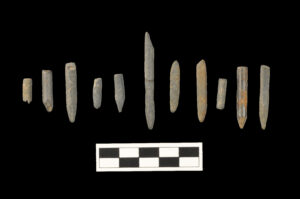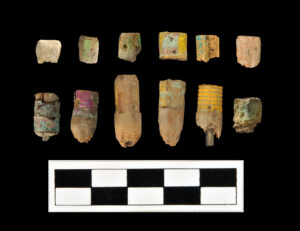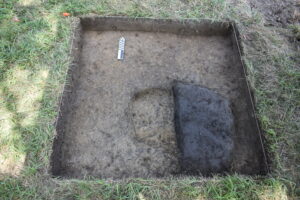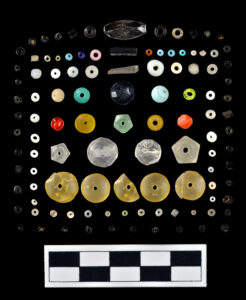- Description
- Updates
- FAQ
- Backers
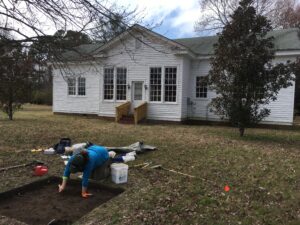 This project will help fund excavations at the Woodville School in Gloucester, Virginia. The standing schoolhouse is a Rosenwald School built in 1923 for the public education of African American children, however there was formerly a circa 1886 two-room school for Black students at the same location. This project seeks to recover as much archaeological information as possible prior to construction of a driveway, turn lane, and parking.
This project will help fund excavations at the Woodville School in Gloucester, Virginia. The standing schoolhouse is a Rosenwald School built in 1923 for the public education of African American children, however there was formerly a circa 1886 two-room school for Black students at the same location. This project seeks to recover as much archaeological information as possible prior to construction of a driveway, turn lane, and parking.
Research design
The Woodville Rosenwald School is located on Route 17 between Ordinary and White Marsh in Gloucester County, Virginia. The site is owned by the Woodville Rosenwald School Foundation, a non-profit organization dedicated to the preservation of the standing 1923 Rosenwald school building and has been listed on the National Register of Historic Places since 2004. A driveway and turn lane are slated to be constructed at the site at the end of August 2021 to make the standing schoolhouse accessible to visitors, likely destroying much of the archaeology associated with both school sites. This project’s aim is to excavate as much of the projected impact areas on the site as possible before they are destroyed.
The Woodville School site is highly significant. Despite the importance of schools, the wide distribution of these community-based institutions, and their central role in the Civil Rights movement, little archaeology has been done on schoolhouses in Virginia or across the United States from the later 19th and 20th centuries. This is especially true for rural Black schools. Only 14 schools are known to have been tested in Virginia across all time periods, and most have only had shovel test surveys.
While historical literature on this subject is vast, the archival record of Black schools was usually written with agendas and from the perspective of activists, parents, or school boards- not teachers and students. Present historical studies generally focus on the architecture, curriculum, and political impact of schools, not what was occurring in the schools. Archaeology provides the means to look at these schools from a material culture perspective, offering a more detailed understanding of day-to-day life and education in Southern rural Black schools and how schools shaped the lives of students and reflected the values of their communities.
The Rosenwald component of the site brings additional significance. Rosenwald Schools were constructed across the American South for rural Black communities between 1913 and 1932 with grants provided by the Rosenwald Foundation, run by Julius Rosenwald, a Chicago philanthropist, and Booker T. Washington. There were five constructed in Gloucester County and Woodville is the only one still standing. There appears to be only one other Rosenwald School excavated in Virginia (the Bethel School, also in Gloucester and part of the same project as the original Woodville excavations) and only two additional Rosenwald Schools across the entire country (one in Georgia and one in Tennessee). These school buildings are fast disappearing with only about 500 of the original 5,357 Rosenwald Schools still remaining. The archaeological sites they were located on are also being destroyed by development, such as what is going to happen at Woodville.
The si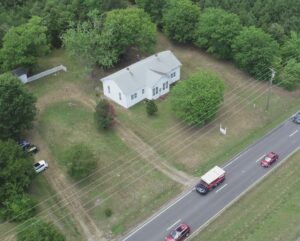 te is located on one acre of land, in an area zoned for commercial use and consists of the two-room 1923 school and a circa 1923 shed, likely a home economics classroom or teacher’s cottage. The 1923 building is a Rosenwald School used as a schoolhouse for Black children from 1923 until 1939 and then it was converted into a domestic residence from 1944 until 2001. It is presently being restored to become an education and Black history center. The site was also the location of an earlier circa 1886–1923 two-room Black school of which little is known historically.
te is located on one acre of land, in an area zoned for commercial use and consists of the two-room 1923 school and a circa 1923 shed, likely a home economics classroom or teacher’s cottage. The 1923 building is a Rosenwald School used as a schoolhouse for Black children from 1923 until 1939 and then it was converted into a domestic residence from 1944 until 2001. It is presently being restored to become an education and Black history center. The site was also the location of an earlier circa 1886–1923 two-room Black school of which little is known historically.
A shovel test survey was conducted across the entire one-acre lot in 2018 by Colleen Betti of UNC Chapel Hill and the Fairfield Foundation. The survey revealed little related to the school period, which is consistent with reports from schoolhouse excavations in the Northeast that shovel tests are relatively ineffective at identifying school sites. In 2019 and 2020 twenty test units were dug on the site, the majority of which (14) were in the front yard. These excavations showed intact cultural layers with large quantities of artifacts and numerous features dating mostly to the earlier 1886 school. However, the 1886 school’s foundations were not found and neither was the location of the 1923 school’s midden.
The planned parking lot and turn lane will cover nearly half of the parcel, mostly in the southern side yard and part of the front yard and will destroy most of the underlying archaeology in those areas. Artifacts dating to the school period are found immediately below the sod and subsoil is approximately 0.80 feet below the surface, so nothing will be preserved under the parking lot.
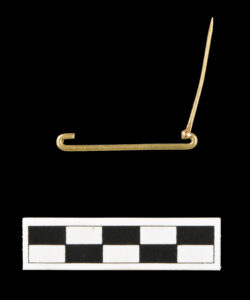
While the turn lane is in a highly disturbed area due to a drainage ditch along the highway, the archaeology is largely intact in the areas to be impacted by the parking lot. The area the parking lot will cover, the southern side yard, has not been extensively tested. The shovel tests showed a low artifact density, but intact layers. The two test units excavated in the southern side yard had low artifact density compared to the front yard but still produced numerous artifacts dating from the combined school periods (such as a gold pin) and some features. This was much more than was expected from the shovel tests and is additional evidence for how shovel tests are not the best predictors of archaeological deposits at school sites and the importance of unit excavation. The purpose and use of this large side yard during the school period is still unclear.
A bus turn around associated with the parking lot will extend into the front yard and will impact most of the area known to contain a dense intact deposit relating to the 1886 school. This deposit’s exact extent is unknown but estimates from the shovel tests suggest it covers most of the current front yard and it appears to be a midden. The portions that have been excavated revealed a number of post holes of varying sizes whose purpose is still unknown and three large holes (3-foot diameter) filled with coal and construction debris dating to circa 1923. This area provides the greatest potential for learning about the 1886 school and locating its foundations.
Methodology
Due to time constraints preventing a larger excavation, we plan to dig a 2% systematic sample across the impacted area. This is 30 additional 5 x 5 foot test units. Units would be excavated with shovels and trowels and all soil screened through ¼ inch mesh. Any features discovered will be recorded and excavated if there is time and if they will be impacted by the construction. Waterscreen samples will be taken from Layer B in the front yard area where it is known there is a concentration of small artifacts, including pencil leads and beads.
Artifacts will be washed by the Fairfield Foundation and their volunteers. All coal, shell, and brick will be weighed and discarded. All other artifacts will be saved. Soil samples will be waterscreened and picked. Artifacts will then be sent to Colleen Betti of UNC Chapel Hill for cataloging.
Curation plan
Artifacts will be returned to the property owners, the Woodville Rosenwald Foundation. They plan to store the artifacts on their property in the restored Woodville Rosenwald School and use some of them in a museum display in the building.
Virginia component description
The excavations will take place in Virginia.
Public product
Updates from the project as it is ongoing will be available on the project’s Facebook (https://www.facebook.com/BethelGlennsWoodvilleSchoolsArchaeology), Instagram (https://www.instagram.com/bethel_glenns_woodville_school) , and Twitter pages (https://twitter.com/BGW_Archaeology). Once all of the cataloging and analysis is complete a report will be made available for download from a dedicated webpage linked to the Fairfield Foundation website (www.fairfieldfoundation.org).
Updates
Project FAQ
- Why is it important to excavate this site if it was used as a school less than 100 years ago? Can't we learn more from the historical documents? 20th (and even 21st) century archaeological sites have the potential to provide a different perspective on the history of a site or subject than photographs, historical documents, and oral histories. This is especially true for sites of marginalized and ignored histories where there are few recorded records and those that are recorded are often biased. In the case of the Woodville School, the historical record is very small, mostly just listing the names of teachers. There are no photographs or descriptions of the original 1886 school and only one historical photograph of the Rosenwald School. While historical documents on schools and segregated education in general are widely available, the archival record of black schools were usually written with agendas and from the perspective of activists, parents, or the school board not teachers and students. Present historical studies generally focus on the architecture and political impact of Rosenwald schools, not what was occurring in the schools. Archaeology provides the means to look at these schools, including Woodville, through artifacts, offering a more detailed understanding of day-to-day life and education in Southern rural black schools and how schools shaped the lives of students and reflected the values of their communities.
- Where can updates be found on the excavations and analysis? You can follow us on social media:
Facebook: www.facebook.com/BethelGlennsWoodvilleSchoolsArchaeology
Instagram: @bethel_glenns_woodville_school
Twitter: @BGW_Archaeology
-
12/01/2021$55.00
-
Anonymous12/01/2021$57.00
-
12/01/2021$55.00
-
12/01/2021In honor of Colleen Betti.$22.00
-
Anonymous11/30/2021$110.00
-
11/30/2021$27.50
-
11/30/2021$55.00
-
Anonymous11/30/2021$100.00
-
11/30/2021$5.00
-
11/30/2021$11.00

